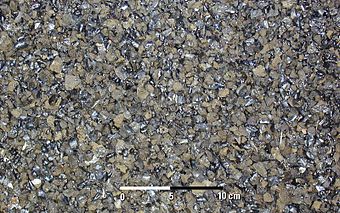
Back لويبات Arabic Лапил Bulgarian Lapil·li Catalan Lapilli Czech Lapilli German Lapilli Spanish Lapill Estonian Lapilli Basque لاپیلی Persian Lapilli Finnish

Lapilli (sg.: lapillus) is a size classification of tephra, which is material that falls out of the air during a volcanic eruption or during some meteorite impacts.[1] Lapilli is Latin for "little stones".
By definition lapilli range from 2 to 64 mm (0.08 to 2.52 in) in diameter.[2] A pyroclastic particle greater than 64 mm in diameter is known as a volcanic bomb when molten, or a volcanic block when solid. Pyroclastic material with particles less than 2 mm in diameter is referred to as volcanic ash.[3][4]
- ^ Bron, K.A. (2010). "Accretionary and melt impactoclasts from the Tookoonooka impact event, Australia". In Reimold W.U. & Gibson R.L. (ed.). Large Meteorite Impacts and Planetary Evolution IV. Special Paper. Vol. 465. The Geological Society of America. p. 222. ISBN 978-0-8137-2465-2. Retrieved 22 May 2011.
- ^ Fisher, R. V. (1961). "Proposed classification of volcaniclastic sediments and rocks". Geological Society of America Bulletin. 72 (9): 1409–1414. Bibcode:1961GSAB...72.1409F. doi:10.1130/0016-7606(1961)72[1409:PCOVSA]2.0.CO;2.
- ^ VHP Photo Glossary: Laplli in USGS Photo Glossary of volcano terms]
- ^ How Volcanoes Work